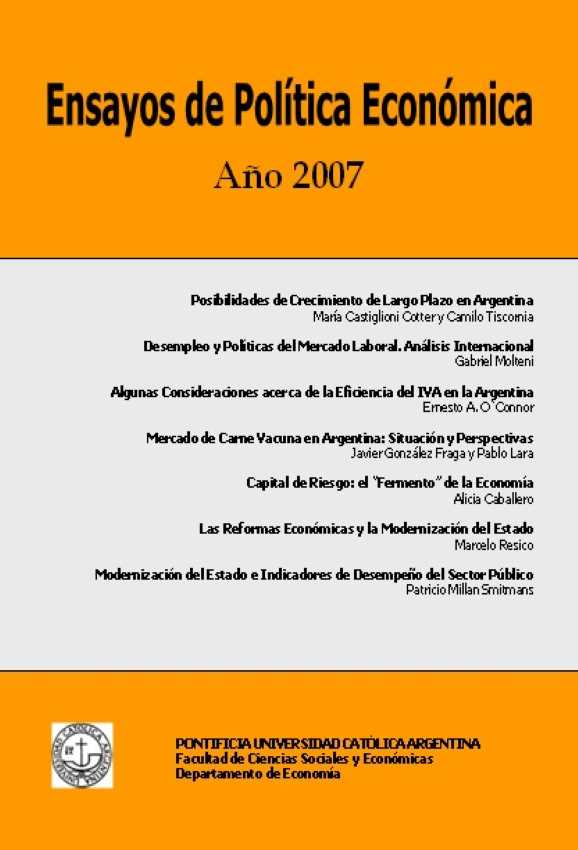Growth Capacity of Argentina in the Long Term
Keywords:
Production capacity, product gapAbstract
Argentina grew 39% between 2003 and 2006. Many circumstances generated this impressive
performance but one of them was decisive: the existence of idle productive capacity after a four
year recession. Thus, the permanent reduction of this idle capacity during the last four years poses two important and related questions: “how fast can the economy grow in the short term?” and “what is the long run growth rate?” To answer both of them we estimate Argentina’s potential GDP and the corresponding output gap using a production function approach. The main conclusion is that in order to attain a 4% long run growth rate the economy needs more and better investment than the one registered today.
Downloads
References
Arora, V. and Bhundia, A. (2003). “Potential Output and Total Factor Productivity Growth in Post-Apartheid in South Africa”, IMF Working Paper 03/178, Washington, International Monetary Fund.
Blanchard, O. and Quah, D. (1989). “The Dynamic Effects of Aggregate Demand and Supply Disturbances”, The American Economic Review, Vol. 79, Nº 4 (Sep 1989), pp 655-673.
Clark, P. (1979). “Potential GNP in the United States, 1948-80”, Review of Income and Wealth, Vol. 25(2) (June), pp 141-65.
Congressional Budget Office (2001). “CBO’s Method for Estimating Potential Output: An Update”, mimeo.
De Masi, P. (1997). “IMF Estimates of Potential Output: Theory and Practice”, IMF Working Paper 97/177, Washington, International Monetary Fund.
Dupasquier, C.; Guay, A. y ST. Amant, P. (1997). “A Comparison of Alternative Methodologies for Estimating Potential Output and the Output Gap”, Bank of Canada Working Paper 97-5.
Elosegui, P., Garegnani, L., Lanteri, L., Lepone, F. y Sotes Paladino, J. (2006). “Estimaciones Alternativas de la Brecha del Producto para la Economía Argentina”, Ensayos Económicos Nº 45 (Oct 2006), Buenos Aires, Banco Central de la República Argentina.
Felipe, J. (1997). “Total Factor Productivity Growth in East Asia: A Critical Survey”, EDRC Report Series Nº 65, Manila, Asian Development Bank.
Greene, W. (1997). “Econometric Análisis”, Prentice Hall, New Jersey.
Instituto Nacional de Estadística y Censos (INDEC): www.indec.gov.ar.
International Monetary Fund (2006). “World Economic Outlook Database for September 2006”, www.imf.org.
Solow, R. (1957). “Technical Change and the Aggregate Production Function”, The Review of Economics and Statistics, Vol. 39, Nº 3 (Aug 1957), pp 312-320.
Ministerio de Economía y Obras y Servicios Públicos (MECON) (1999). “Sistema de Cuentas Nacionales Argentina – Año Base 1993”. Ministerio de Economía y Producción: www.mecon.gov.ar.
Oomes, N. y Dynnikova, O. (2006). “The Utilization-Adjusted Output Gap: Is the Russian Economy Overheating?”, IMF Working Paper 06/68, Washington, International Monetary Fund.
Roldos, J. (1997). “Potential Output Growth in Emerging Market Economies: The Case of Chile”, IMF Working Paper 97/104, Washington, International Monetary Fund.
Romer, D. (2006). “Macroeconomía Avanzada”, Mc Graw Hill, Madrid.
Sala-I-Martin, X.(2000): “Apuntes de Crecimiento Económico”, Antoni Bosch Editor, Barcelona.
Sarel, M. (1997). “Growth and Productivity in ASEAN Countries”, IMF Working Paper 97/97, Washington, International Monetary Fund.
Singh, A. y Cerisola, M. (2006). “Sustaining Latin America’s Resurgence: Some Historical Perspectives”, IMF Working Paper 06/252, Washington, International Monetary Fund.
Downloads
Published
How to Cite
Issue
Section
License







 Ensayos de Política Económica
Ensayos de Política Económica